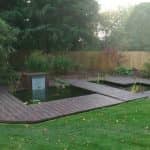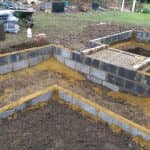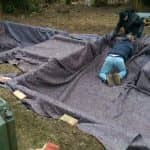When one of my regular customers asked me to sort his very weedy and overgrown pond, little did I know that his passing comment actually meant he wanted to completely revamp the pond.
The pond had been there prior to my becoming his regular gardener and I was to find out that he had originally made the pond himself putting the excavated soil beside the hole and trying, unsuccessfully, to create a waterfall using the mound of soil. His comment was “it had always leaked and had never worked properly even from day one!”.
So started the ‘Pond Project’:
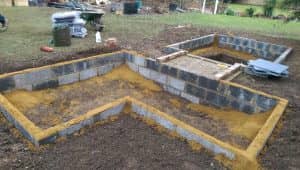 The customer showed me some pictures he had seen online of architectural ponds with wooden walkways between them – this was evidence of what he liked. Clean lines with no fuss, but his brief was that “he wanted to hear running water”.
The customer showed me some pictures he had seen online of architectural ponds with wooden walkways between them – this was evidence of what he liked. Clean lines with no fuss, but his brief was that “he wanted to hear running water”.
I emptied the existing pond to try to work out what shape I was dealing with and realised that the existing area had two virtually separate areas with a raised area between two holes. This gave me the idea to create two separate ponds, one higher than the other with a waterfall between the two. The customer had also requested that he wanted a proper three tier waterfall or even perhaps three separate ponds feeding from one to the other.
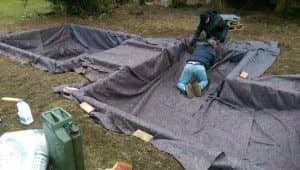 Although we had a lot of space with which to play with, I decided that producing three ponds at different heights may not work, however producing a cascade waterfall from a pump room housing the filter and all the electrics would actually provide the waterfall noise that the customer had requested. He also wanted to lose the mound of soil that was restricting the view of the rest of that area of the garden.
Although we had a lot of space with which to play with, I decided that producing three ponds at different heights may not work, however producing a cascade waterfall from a pump room housing the filter and all the electrics would actually provide the waterfall noise that the customer had requested. He also wanted to lose the mound of soil that was restricting the view of the rest of that area of the garden.
So we brought in a mini-digger and created two separate holes that would allow us to build the sides of two tanks, producing a waterfall area between the two ponds which I could then put a bridge over.
We built the shape of the ponds with concrete breeze blocks, creating the waterfall area using bricks and floating a cement plinth between the two to allow us to use one pond liner over the two areas.
By using both soil and building sand to soften the edges and create some shelves within both ponds, we were ready to put a pond underlay and pond liner over our structures. Once this was complete we were able to produce the pump house/water cascade structure to the side of pool one which would provide the most of the running water noise.
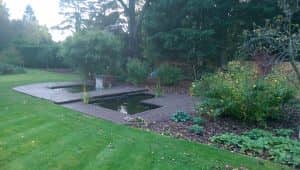 With that complete we then added slate slabs over the pond liner covering the cement plinth that we had created between the two ponds – the key to ensuring a consistent flow coming out the otherside was the inclusion of a gravity fed cascade which I had built by a local fabricators in stainless steel. This gravity fed cascade would be hidden beneath the bridge which would go over the water fall connecting the two pools.
With that complete we then added slate slabs over the pond liner covering the cement plinth that we had created between the two ponds – the key to ensuring a consistent flow coming out the otherside was the inclusion of a gravity fed cascade which I had built by a local fabricators in stainless steel. This gravity fed cascade would be hidden beneath the bridge which would go over the water fall connecting the two pools.
The slate that is visible where the water exits pool one pours water into a reservoir which is perfectly level and has a cascade exit which pours the water out both consistently and at speed due to the fall of the spout. This means that the noise of the water fall will be increased as the water is hitting pool two at a quicker rate.
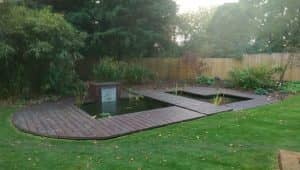 The bridge covering the waterfall, between both ponds was also a specific design with oak beams over a stainless steel frame which comes out of the grass on one side and disappears into the ground on the other side without any visible signs of support. The same fabricator who created the gravity fed cascade also provide the steels for the self-supporting bridge.
The bridge covering the waterfall, between both ponds was also a specific design with oak beams over a stainless steel frame which comes out of the grass on one side and disappears into the ground on the other side without any visible signs of support. The same fabricator who created the gravity fed cascade also provide the steels for the self-supporting bridge.
Landscape planting around the pond and a further wooden edge to the pond to hide the liner produced the architectural look that the customer had requested. The customer was consulted throughout the project and changes were made during the initial stages of the design of the two pools.


